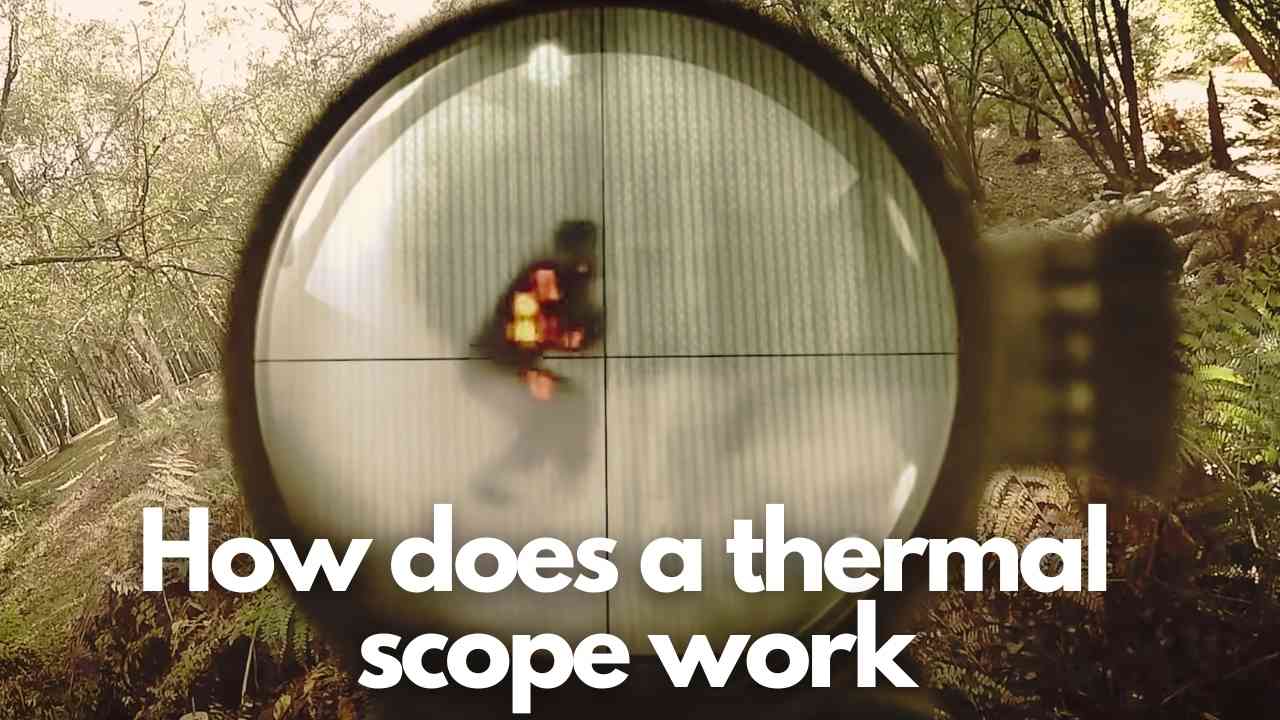
Welcome to the blog about How do Thermal Scopes Work in 2023.
If you have studied the working of a camera or how similar it is to your eye, you would probably know that your viewing capabilities depend on the light conditions you have. If you want to see something, the light that an object emits needs to hit your retina, which is then converted into electrical signals for you to see the thing in view.
We find it hard to see in the dark, and people have always seen this as a restriction. Experts have developed several types of equipment for us to see in the dark. One such gift of technology is the thermal scope.
Thermal technology has allowed people to move beyond this restriction. It does not create an image with light but heat radiations. It is due to this feature that you can see objects in dark light. This article will explain what a thermal scope is, how thermal imaging works, and how it is different from night vision scopes.
What is a thermal scope?
If you have an interest in hunting, you must have heard about a thermal scope. It is a weapon sight that hunters use for hunting nocturnal animals. The use of thermal technology makes thermal scopes to view target objects during the dark. However, its use is not limited to hunting; it is also helpful for surveillance and rescue operations.
A thermal scope is usually confused with night vision optics, but both have different workings. A night vision optic works with ambient light. It collects whatever light is available and amplifies it for the shooter to view the target. However, thermal scopes are different because they don’t use light to function but detect the heat radiations of the object in view. Hence, thermal scopes are more advanced and efficient than night vision optics.
The working of a thermal scope
Infrared light
For understanding the working of thermal scopes, let’s first understand infrared light. The electromagnetic spectrum of light has three parts: infrared spectrum, visible light, and ultraviolet.
The infrared light further divides into three categories: near-infrared, mid-infrared, and thermal infrared. The thermal infrared occupies the most significant part of the infrared spectrum and also has the largest wavelength. It is different from the other two in that thermal infrared is emitted by an object instead of reflecting off it.
All living beings and many nonliving ones consume energy. This energy consumption generates heat. Consequently, heat causes the atoms in that object to give off photons in the thermal infrared spectrum. Hotter objects release photons with a shorter wavelength. Thermal imaging works with this infrared emission.
Whether natural or artificial, every object has a specific infrared energy. It emits that energy in the form of heat. The heat energy that the object in view emits is proportional to its temperature. As everything in sight has a different temperature hence the energy that it emits also varies.
Thermal technology works by detecting the difference in the heat energy emitted by an object from its surroundings. Humans and animals generate more heat than their surrounding environment. The thermal scope captures the difference in the target’s heat and its surrounding environment and presents an image. Most modern thermal scopes offer the final image in different color modes and not just black and white.
How thermal imaging works?
The infrared detector fixed in the thermal scope has an optic lens that focuses the emitted energy onto an infrared sensor.
The scope also has a phased arrangement of infrared-detector elements that scans the focused light captured by the lens. These infrared-detector elements form a temperature pattern called a thermogram. This created thermogram gets converted into electric impulses.
These impulses then move to the signal processing unit. The signal processing unit is a circuit board that converts the signals into data. This data is then sent to the display by the processing unit, and there the display presents the image.
The new generation Thermal Scopes
The new generation thermal scopes also include sharing features. You can now record the whole shooting experience on your thermal imaging device and share it on YouTube and other video-sharing websites.
Image Enhancement and Night Vision
The working of a night vision scope is different from that of a thermal scope. Night vision works with image enhancement technology. A night vision device uses an objective lens to collect light that bounces off of an object. The intensifier tube present in the device receives that light enhances it, and sends it into the eyepiece. The image it produces is greenish.
As the night vision devices need some form of light to function, hence they cannot work in total darkness. A thermal scope has no such limitation.
Digital night vision
Digital night vision uses a coupler device instead of the conventional intensifier tube for image enhancement. Its displayed image is black and white, which is more precise than traditional night vision. You can use them during the day as well.
When to use a thermal scope?
In the beginning, only military personnel would use thermal scopes. But now, due to the advancement in technology, they have become more accessible for civilians.
The thermal scope is best known for working in the dark, shooting nocturnal animals such as feral hogs and coyotes. You can also detect animals through thick bushes and dense fog using a thermal scope. Moreover, tactical shooting is another purpose for which we can use them.
Also, security personnel can use thermal scopes for surveillance purposes, and rescue teams can use them for finding signs of life in a calamity. One engaging quality of thermal scopes is that they work well in dense fog and other extreme conditions such as smoke or dust.
find the Best Thermal Scope under 5000.
Advantages of using a Thermal Scope
The efficiency and high performance of a thermal scope are why it is loved by shooters so much. Every shooting scope has its advantages. Some benefits of thermal scope are listed below:
Works in complete darkness
You don’t need to carry two separate devices for day and night shooting if you have a thermal scope. A thermal scope can efficiently work in complete darkness. It also works equally well during the day. No amount of bright sunlight can affect the efficacy of a thermal scope.
It can see through tall bushes
Thermal imaging devices can also see through tall bushes and detect animals that are sleeping or bedded. Also, farmers can catch the hogs that destroy their farms using a thermal scope.
Works for long ranges
A thermal scope works well at long distances. You can detect your target as far as 1000 yards. You might not know what the target is, but you will have an idea if something is there. Also, advanced thermal scopes can identify a target up to 4000 yards.
Accuracy
One other advantage of a thermal scope is its accuracy. As thermal scope uses thermal imaging technology for capturing images of the target, it gives a better view that helps in accurate target acquisition.
Wrapping up
Thermal scopes have revolutionized nighttime hunting. They work by reading the difference in the temperature of an object from its surroundings and hence detect it. Unlike night vision devices, thermal devices can work in complete darkness. As a thermal scope works by detecting heat, it can see through tall bushes, dense fog, and smoke.
Thermal scopes are often confused with night vision scopes, but they are different. A night vision works by enhancing whatever light is available in their surroundings. A thermal scope, on the other hand, doesn’t need light to function.
Frequently asked questions
How does a thermal rifle scope work?
A thermal rifle scope works by detecting the difference in the heat energy emitted by an object from its surroundings. Humans and animals generate more heat than their surrounding environment. A thermal scope detects the difference in the target’s heat and its surrounding environment and presents an image.
Can you use a thermal scope during the day?
Thermal scopes are well known for working efficiently at night. But they equally work well in the day as well. No amount of bright sunlight affects the working of a thermal scope.
How far do thermal scopes work?
An entry-level thermal scope works up to 1000 yards, and a high-quality scope can identify a target up to 4000 yards.
Can thermal scopes see through walls?
A thermal scope cannot detect an object behind a wall. It can only identify from the surface of the wall but not beyond it.
Why are thermal scopes not used for target shooting?
Thermal scopes are not the practical choice for target shooting. In target shooting, you need to see the specific features of the animals that are not visible in a thermal scope. A thermal scope only gives outlines of the target.
What are the top brands that produce thermal scopes?
Some popular brands of thermal scopes are Atn, Pulsar, Trijicon, and Armasight.
What are the critical components of a thermal scope?
The key features that you need to consider while buying a thermal scope are the diameter of the lens, thermal refresh rate, reticle patterns, and battery life.
Is it legal to use thermal scopes?
The use of thermal scope is legal in the United States.
What is Scout Scope?
The scout scope can be described as an integral part of the rifle. It is a low-powered rifle scope specially designed to enhance precision and accuracy without dwelling aim achievement
